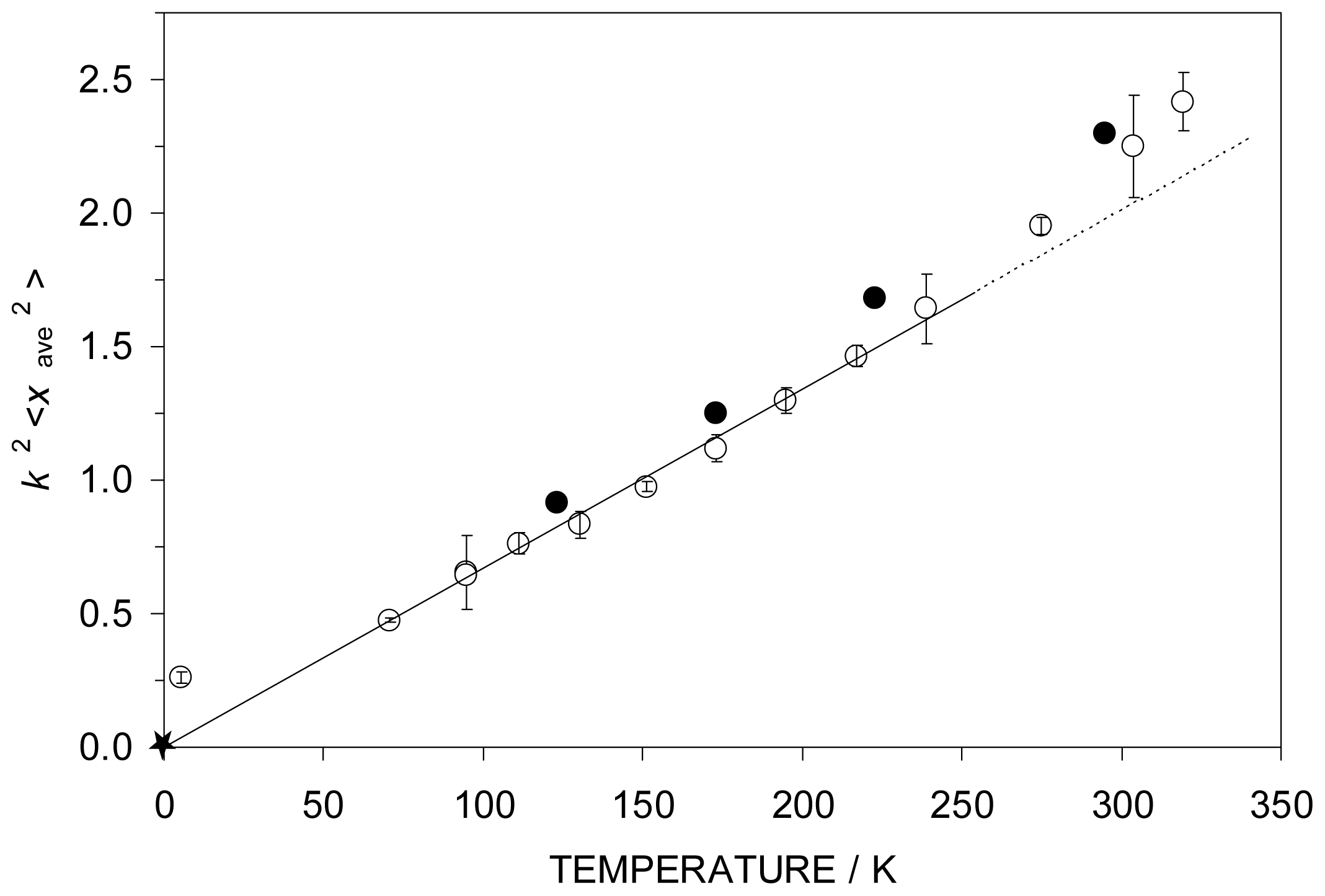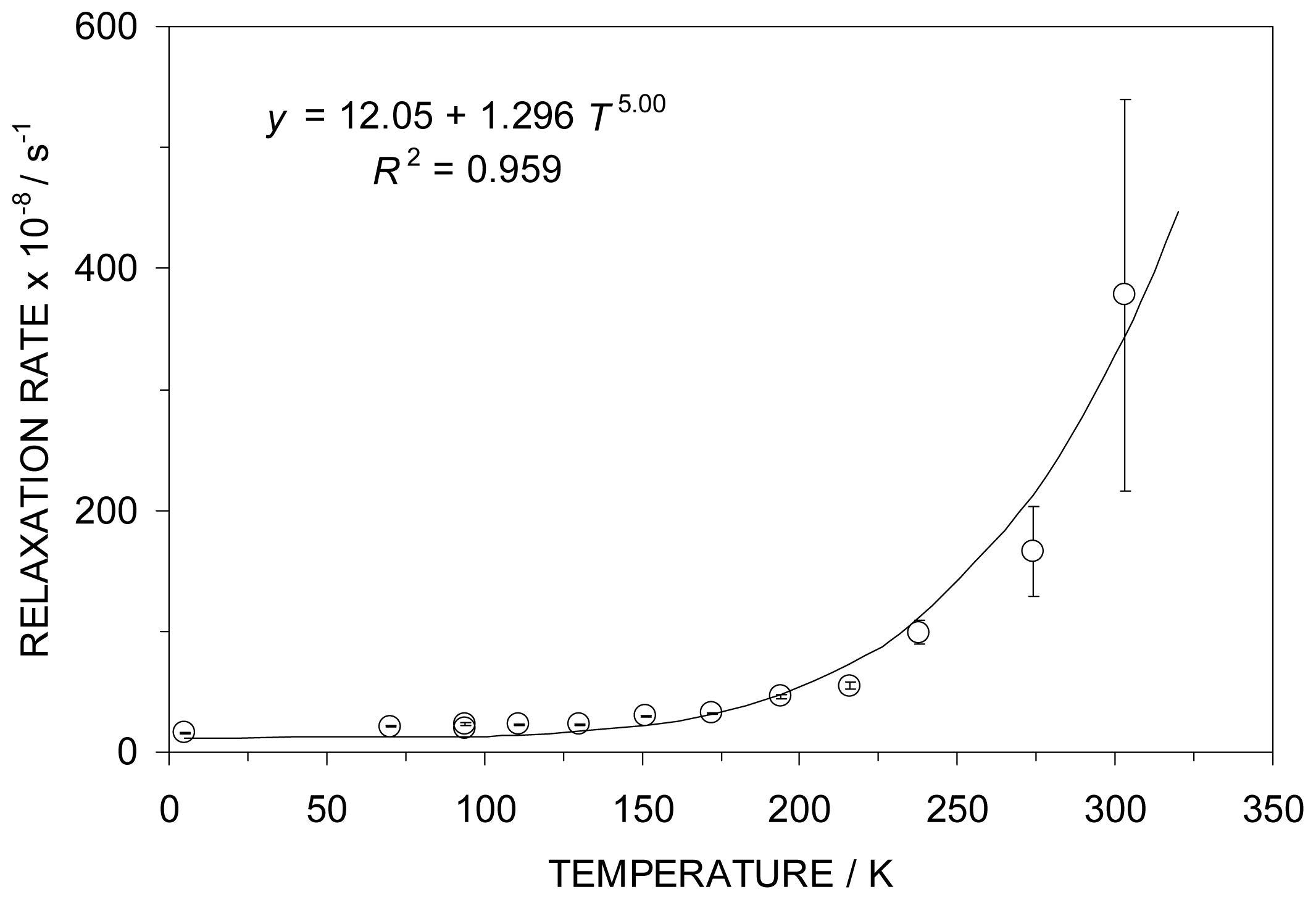Mössbauer Spectroscopy and X-ray Diffraction Study of 57Fe-Labeled Tetrachloroferrate(III)-Based Magnetic Ionic Liquids
Abstract
:1. Introduction
2. Results and Discussion
2.1. (1-Butyl-3-Methylimidazolium) (57FeCl4) (1)
2.2. (1-Allyl-3-Methylimidazolium) (57FeCl4) (2)
2.3. (1-Methyl-1-Propylpyrrolidinium) (57FeCl4) (3)
2.4. (Tetraphenylphosphonium) (57FeCl4) (4)
 = k2<xave 2>, where k is the wave vector of the gamma radiation and <xave 2> is the mean square amplitude of vibration of the metal atom. This latter quantity can similarly be calculated from the Uij values of the X-ray diffraction data, and thus
= k2<xave 2>, where k is the wave vector of the gamma radiation and <xave 2> is the mean square amplitude of vibration of the metal atom. This latter quantity can similarly be calculated from the Uij values of the X-ray diffraction data, and thus
 can be compared between the two techniques. This comparison is shown in Figure 3 in which the open points are those derived from the Mössbauer experiments (
can be compared between the two techniques. This comparison is shown in Figure 3 in which the open points are those derived from the Mössbauer experiments (
 ), while the filled data points refer to the X-ray data (
), while the filled data points refer to the X-ray data (
 ). As will be seen from the figure, the
). As will be seen from the figure, the
 and
and
 data are in quite reasonable agreement. The departure from linearity in the high temperature regime arises from the population of low frequency vibrational (or librational) motions in the solid. The starred data point is the k2<xave 2> value when the high T data are extrapolated to T = 0 K, making the assumption that f → 1 in the low T limit.
data are in quite reasonable agreement. The departure from linearity in the high temperature regime arises from the population of low frequency vibrational (or librational) motions in the solid. The starred data point is the k2<xave 2> value when the high T data are extrapolated to T = 0 K, making the assumption that f → 1 in the low T limit.3. Experimental Section
3.1. General Procedure for the Synthesis of 1–4
3.2. (1-Butyl-3-Methylimidazolium) 57FeCl4 (1)
3.3. (1-Allyl-3-Methylimidazolium) 57FeCl4 (2)
3.4. (1-Methyl-1-Propylpyrrolidinium) 57FeCl4 (3)
3.5. (Tetraphenylphosphonium) 57FeCl4 (4)
3.6. X-ray Crystallography
3.7. Mössbauer Spectroscopy
4. Conclusions
 values have been found to be in excellent agreement with the
values have been found to be in excellent agreement with the
 data extracted from single crystal X-ray data. The iron atom in this compound is found to relax by a Raman process, the relaxation rate depending on T~5.
data extracted from single crystal X-ray data. The iron atom in this compound is found to relax by a Raman process, the relaxation rate depending on T~5.Acknowledgments
References
- De Pedro, I; Rojas, DP; Albo, J; Luis, P; Irabien, A; Blanco, JA; Fernandez, JR. Long-range magnetic ordering in magnetic ionic liquid: Emim[FeCl4]. J Phys Condens Matter 2010, 22, 296006:1–296006:4. [Google Scholar]
- Okuno, M; Hamaguchi, HO; Hayashi, S. Magnetic manipulation of materials in a magnetic ionic liquid. Appl Phys Lett 2006, 89, 132506:1–132506:2. [Google Scholar]
- Li, M; De Rooy, SL; Bwambok, DK; El-Zahab, B; Di Tusa, JF; Warner, IM. Magnetic chiral ionic liquids derived from amino acids. Chem. Commun 2009, 2009, 6922–6924. [Google Scholar]
- Lee, SH; Ha, SH; Ha, SS; Jin, HB; You, CY; Koo, YM. Magnetic behavior of mixture of magnetic ionic liquid [bmim]FeCl4 and water. J Appl Phys 2007, 101, 09J102:1–09J102:3. [Google Scholar]
- Lee, SH; Ha, SH; You, CY; Koo, YM. Recovery of magnetic ionic liquid [bmim]FeCl4 using electromagnet. Korean J. Chem. Eng 2007, 24, 436–437. [Google Scholar]
- Yoshida, Y; Saito, G. Influence of structural variations in 1-alkyl-3-methylimidazolium cation and tetrahalogenoferrate(III) anion on the physical properties of the paramagnetic ionic liquids. J. Mater. Chem 2006, 16, 1254–1262. [Google Scholar]
- Del Sesto, RE; McCleskey, TM; Burrell, AK; Baker, GA; Thompson, JD; Scott, BL; Wilkes, JS; Williams, P. Structure and magnetic behavior of transition metal based ionic liquids. Chem. Commun 2008, 4, 447–449. [Google Scholar]
- Mallick, B; Balke, B; Felser, C; Mudring, AV. Dysprosium room-temperature ionic liquids with strong luminescence and response to magnetic fields. Angew. Chem. Int. Ed 2008, 47, 7635–7638. [Google Scholar]
- Sitze, MS; Schreiter, ER; Patterson, EV; Freeman, RG. Ionic liquids based on FeCl3 and FeCl2. Raman scattering and ab initio calculations. Inorg. Chem 2001, 40, 2298–2304. [Google Scholar]
- Hayashi, S; Hamaguchi, H-O. Discovery of a magnetic ionic liquid [bmim]FeCl4. Chem. Lett 2004, 33, 1590–1591. [Google Scholar]
- Hayashi, S; Saha, S; Hamaguchi, HO. A new class of magnetic fluids: Bmim[FeCl4] and nbmim[FeCl4] ionic liquids. IEEE Trans. Magn 2006, 42, 12–14. [Google Scholar]
- James, BD; Juraja, SM; Liesegang, J; Reiff, WM; Skelton, BW; White, AH. 4-Piperidinylpyridinium tetrachloroferrate(III): Structure and low-temperature magnetic ordering. Inorg. Chim. Acta 2001, 312, 88–92. [Google Scholar]
- Partiti, CSM; Rechenberg, HR. Lattice and molecular dynamics in (C2H5)4NFeX4 (X = Cl, Br). Hyperfine Interactions 1992, 70, 1075–1078. [Google Scholar]
- Edwards, PR; Johnson, CE. Mössbauer hyperfine interactions in tetrahedral Fe(III) ions. J. Chem. Phys 1968, 49, 211–216. [Google Scholar]
- Wyrzykowski, D; Maniecki, T; Pattek-Janczyk, A; Stanek, J; Warnke, Z. Thermal analysis and spectroscopic characteristics of tetrabutylammonium tetrachloroferrate(III). Thermochim. Acta 2005, 435, 92–98. [Google Scholar]
- Herber, RH. Chemical Mössbauer Spectroscopy; Herber, RH, Ed.; Plenum Press: New York, NY, USA, 1984; p. 199. [Google Scholar]
- Herber, RH; Nowik, I. Hyperfine interactions and metal atom dynamic effects of pentafluorophenyl substituents on ferrocene complexes. J. Nucl. Radiochem. Sci 2008, 9, 33–36. [Google Scholar]
- Wickman, HH; Wertheim, GK. Chemical Applications of Mössbauer Spectroscopy; Goldanskii, VI, Herber, RH, Eds.; Plenum Press: New York, NY, USA, 1968; Volume Chapter 11, pp. 548–621. [Google Scholar]
- Abragam, A; Bleany, B. Electron Paramagnetic Resonance of Transition Ions; Clarendon Press: Oxford, UK, 1970; pp. 560–561. [Google Scholar]
- CCDC CIF Depository Request Form for Data Published from 1994; CCDC: Cambridge, UK. Available online: http://www.ccdc.cam.ac.uk/data_request/cif accessed on 4 August 2011.
- Herber, RH; Nowik, I. Metal atom dynamics in organometallics: Vibrational amplitude determination for bis phosphino ferrocenes including a waxy system. J. Organomet. Chem 2008, 693, 3007–3010. [Google Scholar]
- Data Acquisition Software—No Cost, Universal, and Easy-to-Use; MegaDaq Homepage. Available online: http://www.megadaq.com accessed on 20 September 2011.
- Clausen, CA, III; Good, ML. Mössbauer Effect Methodology; Gruverman, IJ, Ed.; Plenum Press: NY, USA, 1968; Volume 4, pp. 187–200. [Google Scholar]





| 1 | 2 | 3 | 4 | |
|---|---|---|---|---|
| IS(90)/mm s−1 | 0.310(7) | 0.310(4) | 0.311(6) | 0.333(8) |
| QS(90)/mm s−1 | 0.211(7) | 0.187(7) | 0.234(8) | 0.392(8) |
| Meff/Da | 102 ± 13 | 87 ± 7 | 79 ± 10 | 67 ± 1 |
| θM/K | 67 ± 4 | 90 ± 4 | 120 ± 9 | 131 ± 1 |
| T/K | 295 | 223 | 173 | 123 |
|---|---|---|---|---|
| CCDC no. | 792734 | 792735 | 792736 | 792737 |
| Empirical Formula | C24H20P·Cl4Fe | |||
| Formula Weight | 537.02 | |||
| Crystal System | tetragonal | |||
| Space Group | I 4̄ | |||
| a, b/Å | 12.9906(6) | 12.9701(6) | 12.9515(6) | 12.9483(5) |
| c/Å | 7.2022(6) | 7.1128(6) | 7.0548(5) | 7.0090(5) |
| V/Å3 | 1215.41(13) | 1196.54(13) | 1183.38(11) | 1175.12(11) |
| Z | 2 | |||
| Dc/g cm−3 | 1.467 | 1.491 | 1.507 | 1.518 |
| μ/mm−1 | 1.14 | 1.15 | 1.17 | 1.17 |
| F(000)/e | 546 | |||
| Crystal Size/mm | 0.32 × 0.32 × 0.24 | |||
| θmax/° | 29.2 | 29.3 | 29.4 | 29.2 |
| Index Range | −16 ≤ h ≤ 17; −17 ≤ k ≤ 17; −8 ≤ l ≤ 9 | −14 ≤ h ≤ 16; −17 ≤ k ≤ 16; −7 ≤ l ≤ 9 | −16 ≤ h ≤ 14; −17 ≤ k ≤ 13; −9 ≤ l ≤ 9 | −11 ≤ h ≤ 16; −16 ≤ k ≤ 17; −8 ≤ l ≤ 9 |
| Reflections Collected | 5151 | 4853 | 5040 | 4742 |
| Independent Reflections, Rint | 1478, 0.031 | 1471, 0.030 | 1474, 0.033 | 1446, 0.027 |
| Reflections Observed (≥ 2σ) | 1079 | 1301 | 1300 | 1382 |
| Absorption Correction | multi-scan | |||
| Tmin, Tmax | 0.893, 1 | 0.986, 1 | 0.971, 1 | 0.937, 1 |
| Data/Restraints/Parameters | 1478/0/69 | 1471/0/69 | 1474/0/69 | 1446/0/69 |
| Goodness of fit on F2 | 0.89 | 1.07 | 1.00 | 1.03 |
| Final R1, wR2 [(I > 2σ(I)] | 0.029, 0.061 | 0.033, 0.064 | 0.027, 0.056 | 0.026, 0.050 |
| Final R1, wR2 (all data) | 0.049, 0.063 | 0.041, 0.070 | 0.034, 0.057 | 0.028, 0.052 |
| Largest Diff. Peak, Hole/e Å−3 | 0.32, −0.29 | 0.44, −0.43 | 0.37, −0.40 | 0.26, −0.23 |
| Flack Parameter | 0.01(2) | −0.01(2) | 0.026(19) | 0.016(19) |
© 2011 by the authors; licensee MDPI, Basel, Switzerland. This article is an open-access article distributed under the terms and conditions of the Creative Commons Attribution license (http://creativecommons.org/licenses/by/3.0/).
Share and Cite
Herber, R.H.; Nowik, I.; Kostner, M.E.; Kahlenberg, V.; Kreutz, C.; Laus, G.; Schottenberger, H. Mössbauer Spectroscopy and X-ray Diffraction Study of 57Fe-Labeled Tetrachloroferrate(III)-Based Magnetic Ionic Liquids. Int. J. Mol. Sci. 2011, 12, 6397-6406. https://doi.org/10.3390/ijms12106397
Herber RH, Nowik I, Kostner ME, Kahlenberg V, Kreutz C, Laus G, Schottenberger H. Mössbauer Spectroscopy and X-ray Diffraction Study of 57Fe-Labeled Tetrachloroferrate(III)-Based Magnetic Ionic Liquids. International Journal of Molecular Sciences. 2011; 12(10):6397-6406. https://doi.org/10.3390/ijms12106397
Chicago/Turabian StyleHerber, Rolfe H., Israel Nowik, Mirco E. Kostner, Volker Kahlenberg, Christoph Kreutz, Gerhard Laus, and Herwig Schottenberger. 2011. "Mössbauer Spectroscopy and X-ray Diffraction Study of 57Fe-Labeled Tetrachloroferrate(III)-Based Magnetic Ionic Liquids" International Journal of Molecular Sciences 12, no. 10: 6397-6406. https://doi.org/10.3390/ijms12106397
APA StyleHerber, R. H., Nowik, I., Kostner, M. E., Kahlenberg, V., Kreutz, C., Laus, G., & Schottenberger, H. (2011). Mössbauer Spectroscopy and X-ray Diffraction Study of 57Fe-Labeled Tetrachloroferrate(III)-Based Magnetic Ionic Liquids. International Journal of Molecular Sciences, 12(10), 6397-6406. https://doi.org/10.3390/ijms12106397





